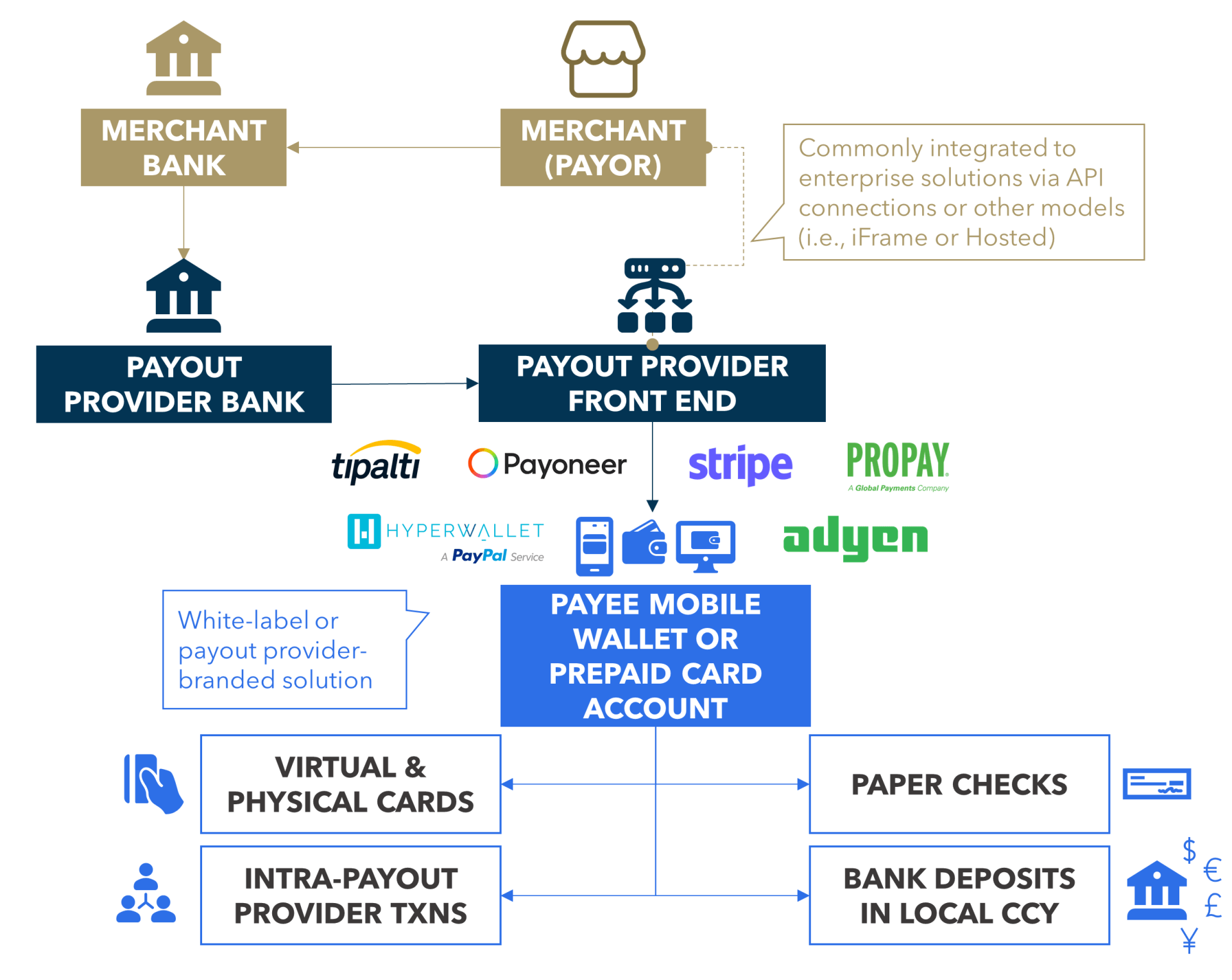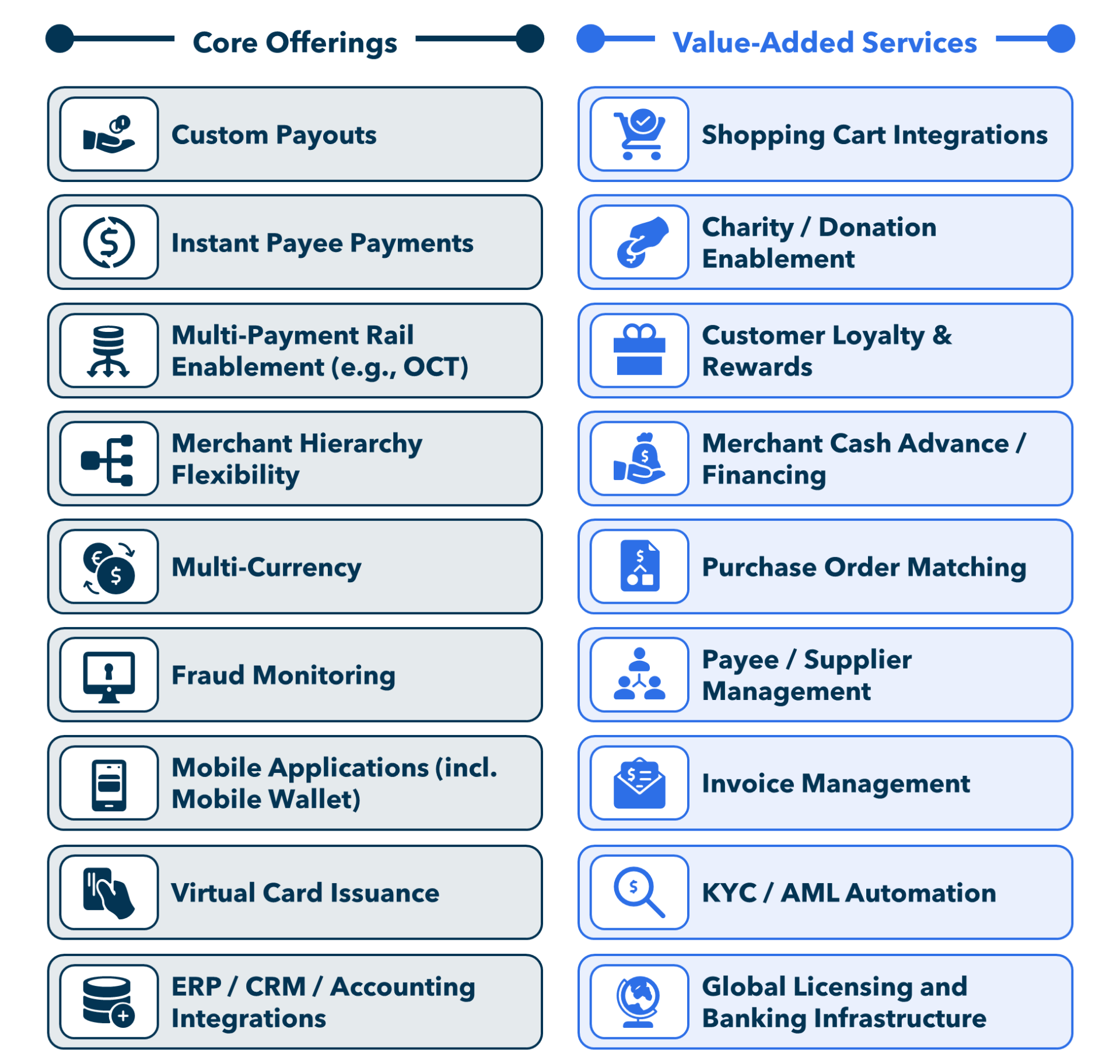The growth of e-commerce and the gig-economy transformed businesses and gave rise to marketplaces and aggregators like Amazon, AirBnB, Upwork, and more. Global payout providers support marketplaces and aggregators, enabling merchant payment disbursements and cross-border money transfers to pay sellers, employees, agents, and/or consumers (‘payees’). These global payout providers are bridging the gap between traditional B2B and B2C payment disbursements and modern digital payments experiences. This article discusses the growth of global payouts, using Payoneer’s recent IPO for illustration.
Payoneer IPO
Payoneer is a leading global payout provider that recently IPO’ed on the US Nasdaq. Payoneer’s IPO provides evidence of investors’ keen interest in global disbursements, marketplace enablement, and SaaS and integrated payments opportunities. The rise of marketplaces and the gig economy created demand for a new form of agile, modern global payouts, which is powered Payoneer and other payout specialists’ rapid growth.
Payoneer went public on June 28, 2021 and, as of the date of this article, is trading at 6.3x EV/revenue multiple. As highlighted in Figure 1, Payoneer demonstrated impressive revenue and volume growth from its mass payment / payment disbursement proposition suite. Its primary geographies include China and the United States, accounting for 37% and 10% of revenues respectively for the six months ending June 30, 2021. The remaining 53% of revenue is split among more than 190 other countries. However, Payoneer is still in an early-stage growth phase and has an operating loss of 10% for the six months ending June 30, 2021.
FIGURE 1: Payoneer Quarterly Revenues and Volume Growth (volume and revenues in $ mil.)

Volume: Total dollar value of transactions successfully enabled by Payoneer’s platform, not including payment orchestration
Take Rate: Percentage of Volume earned as revenue
Sources: Payoneer, Flagship Analysis
Growing Demand for Global Payout Solutions
The continued evolution of commerce and payments technology is spurring demand for global payouts and disbursements. Mastercard estimates that the gig-economy alone will generate more than $450 billion in payments volume globally in 2023, growing at an estimated 17% CAGR during that time (Mastercard’s 2019 whitepaper is published here).
Payees also demand more customized options for receiving payouts. According to a recent survey conducted by PYMNTS and Tango Card in the U.S., 49% of payment recipients would prefer to receive payments via a digital wallet or direct deposit and more than half of recipients would be willing to pay part of the payment values to receive payments in their preferred method (PYMNTS’s study is available here).
Figure 2 illustrates how global payout providers are enabling merchants to fulfill a variety of global payout use cases. Payout specialists connect merchants’ legacy financial institutions and enterprise solutions to a separate bank account established by the payout specialist with one of its various bank partners. The payout provider disburses payments from this account to white-labeled mobile wallets or pre-paid card solutions through which payees can access their funds directly. Merchants capitalize on payees’ willingness to pay for customized disbursements by offering various payout options such as virtual and physical card payments, local bank deposits, and paper checks within user-friendly digital interfaces.
FIGURE 2: Illustrative Global Payout Disbursement Solution

Illustrative and not indicative of Payoneer or any specific global payment provider’s current processes or capabilities
Source: Flagship market observations
Winning in Global Payment Disbursements
Today’s leading global payout providers are enabling domestic and cross-border/cross-currency disbursements along with value-added services, like accounts-payable automation and prepaid/virtual card issuance (Figure 3 lists commonly observed global payment disbursement capabilities). The keys to success in the global payment disbursements space include:
1. Progressing multi-rail enablement: Enabling payments via payees’ preferred form factor is fundamental to global payout providers’ value proposition. E-wallets, virtual cards, physical cards, cross border money movement, OCT, and traditional bank transfers are just some of the methods for payout providers to consider. These methods serve not only diverse payout segments but also industry vertical needs (explained further in #3 below).
2. Expanding into value-added services: Global payout providers are investing in unique value-added services to differentiate themselves. Payoneer has demonstrated a willingness to invest in VAS including multi-currency virtual accounts and payments orchestration. In fact, Payoneer acquired Optile in 2019, a payments orchestration platform designed to simplify enterprise payments infrastructure for merchants by abstracting the complexities of managing multiple payments service providers and value-added service relationships (Flagship discusses payment orchestrators in more detail here).
3. Developing industry/vertical specialization: Merchants are no longer looking for cookie-cutter business and payments solutions but rather integrated solutions that address niche industry challenges. For this to happen, PSPs need ISV integrations and/or in-house business solutions. Two such examples include Greenphire (clinical trials) and Vpay (insurance) which embed payout capabilities within other vertical-specific business solutions (e.g., trial budget development, participant travel booking, mobile insurance claims, tax compliance, etc.).
4. Enabling B2B payments capabilities: Disbursements and payouts offer a new source of value for traditional B2B payments enablers. While many B2B solutions strictly offer domestic payment capabilities, global payout providers offer cross-border solutions that are critical for multi-national enterprises. As such, successful payout providers need to sharpen their own B2B focus to capture the addressable market opportunity. Tipalti does this well by wrapping in-house smart payables, supplier management tools, and procure-to-pay capabilities around its own global payout solution.
Global payouts require unique capabilities, which have allowed specialists like Payoneer to thrive. As payout demand scales and ‘goes mainstream’, we expect other fintechs to expand their capabilities for and focus on this segment of the market.
FIGURE 3: Commonly Observed Global Payment Disbursement Capabilities

Source: Flagship market observations
Payoneer’s recent valuation spotlights the value of global payouts as a payments domain with rapid growth and innovation. With the ongoing expansion of the gig-economy and marketplaces, we expect strong growth for payout demand and an ongoing mainstreaming of global payouts as a core capability for a variety of fintech segments.
Please do not hesitate to contact Rom Mascetti Rom@FlagshipAP.com or Scott DeHaven Scott@FlagshipAP.com with comments or questions.



